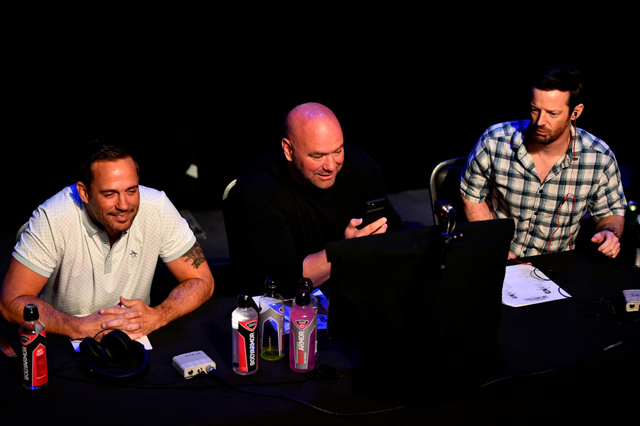Opinion: A Masterclass in Awful Matchmaking

It has been two and a half years since I wrote about how badly Mick Maynard and Sean Shelby screwed up the Ultimate Fighting Championship heavyweight division with their blunders, the ramifications of which are still felt today. However, they weren’t getting enough attention lately, so they decided to one-up themselves in a classic hold-my-beer moment. Instead of just one example of nonsensical, counterproductive matchmaking, how about an entire card full of it? Dear readers, I present to you UFC Fight Night 219. Let’s take a gander at three particularly egregious examples:
Jim Miller vs. Alexander Hernandez
Miller is one of the most enduring, beloved fighters in the history of the UFC and stepped into the Octagon for a record 41st time against Hernandez. For context, even Donald Cerrone only had 38 appearances. While no longer in his prime, Miller can still fight, as he was riding a three-match winning streak ahead of the Hernandez bout, with his last being a guillotine submission of the aforementioned Cerrone. A logical booker would make each of Miller’s last appearances special and likely put him in against fellow aging stars.
Advertisement
Zac Pauga vs. Jordan Wright
This was one of the worst co-main events in UFC history, a seemingly bold statement when one considers that it includes “The Ultimate Fighter” finales, awful heavyweight bouts like Carlos Felipe-Yorgan De Castro and the dark years in the late 1990s when the promotion was banned by many pay-per-view carriers prior to the Zuffa era. Pagua was a 5-1 fighter about to turn 35 who had just been knocked out by Mohammed Usman, and Wright was 2-4 in the UFC, with all of his losses coming via stoppage. These aren’t “bad” fighters in a vacuum, but they wouldn’t be considered “UFC caliber” even a few years ago and would likely be having this same battle in the Legacy Fighting Alliance. Now, they’re co-headlining a UFC event?
However, I don’t blame Maynard and Shelby for the fight itself. The
lousy matchmaking comes in putting this on as the co-main event.
Presumably, this was a flex on the roster, telling the rest of the
fighters that neither records nor performances matter much and that
they can put whoever they want in whatever order they want. Don’t
get a big head, random fighter, or we’ll boot you out the door the
way we did reigning UFC heavyweight champion Francis
Ngannou and promote another fight for the vacant, farcical belt
fans will happily support.
At least Pagua-Wright was guaranteed to have a highlight-reel finish... right? No, the UFC just ended up looking foolish. Apparently, no one told the matchmakers that when you pit a 0-1 fighter in your promotion against one who sits at 2-4, they’re not looking to be exciting. They’re simply looking to win and keep their jobs, as a loss likely means being cut, co-main event or not. Of course, no one informed them that with lower-level fighters, there are many ways of attaining a clear, risk-free victory that makes for awful viewing. Think lay-and-pray or wall-and-stall, the latter especially relevant when Wright lacks grappling skills and has been pushed against the cage and kept there in almost all of his UFC appearances. What did Pagua do? You guessed it. He pushed Wright against the wall, landed some elbows and dirty boxing, then took the easy decision. I don’t blame Pagua for doing what he needed to do to feed his family. I blame the big brains at the UFC for missing this simple logic.
Erin Blanchfield vs. Jessica Andrade
If a drunkard staggers into a casino to play poker, goes all-in on the first hand without seeing his cards and then gets lucky and doubles his money, we don’t applaud him for hidden genius. Similarly, just because everything went perfectly for the UFC in the main event doesn’t make the matchmaking any less idiotic. The original headliner between Blanchfield and Taila Santos made sense. Santos had lost to UFC flyweight champion Valentina Shevchenko via split decision in a match many had her winning. Thus, the winner of Blanchfield-Santos would become a tremendous challenger for the flyweight crown. Also, the loser wouldn’t be hurt too badly.
That wasn’t true of the new main event between Blanchfield and Andrade. What exactly were the UFC’s plans if Andrade had won? Andrade had challenged for the flyweight crown in 2021, when she was decimated by Shevchenko in one of the most thorough beatings I’ve seen in a title fight. Absolutely no one would want to see Andrade challenge Shevchenko again. Meanwhile, an electrifying young prospect like Blanchfield would be knocked down several pegs and have to build herself back up. Even if she managed to do so, many would give her little chance against Shevchenko given that she had lost to a common opponent in Andrade, further diminishing any such showdown.
Andrade winning was likely, too. She was a small favorite, and Blanchfield had never before fought anyone of her caliber. The UFC lucked out big time, as Blanchfield was up to the challenge and finished Andrade in the second round, just as Shevchenko had. Again, the company would have been in a horrible position if she had not done so. When you need the underdog coming through in spectacular, decisive fashion to keep the title picture from turning to shambles, you’ve made a terrible mistake.
Anyhow, I hope you’ve appreciated this stroll through the matchmaking of UFC Fight Night 219. It was a true masterclass by Shelby and Maynard in how not to book fights.
More




 Sherdog Opinion
Sherdog Opinion


